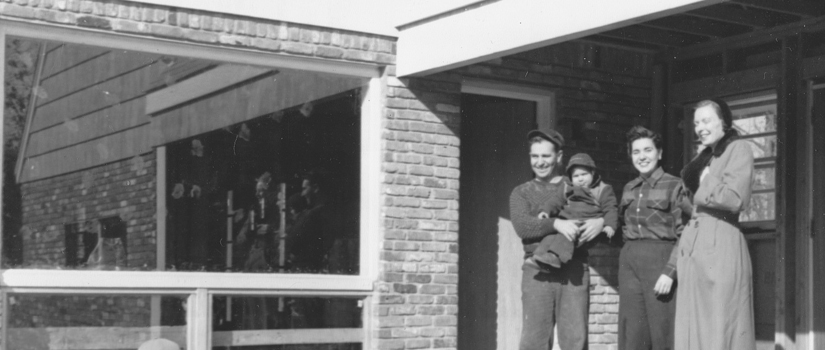A TALE OF MODERN-DAY HOMESTEADING
Ron Roel
AFTER THE SECOND WORLD WAR, MY FATHER, ED ROEL, WAS LIVING WITH HIS PARENTS IN BROOKLYN, RAISING A YOUNG FAMILY WITH HIS WIFE, LESLIE ADELE, AND WORKING AS AN ENGINEER FOR THE SPERRY GYROSCOPE CO. IN GREAT NECK, LONG ISLAND. With a group of 12 Sperry engineers my father decided to strike out for the wilds of the island, forging a communal project he named “Bonnie Downs”—the Good Hills. “We were a group of amateurs, with no previous experience—just guts,” my father would write years later. Where there had been scrub forests and rock-filled terrain, this intrepid band of Sperryites created a sense of place.
After a few false starts, they found a 30-acre parcel on a hilltop along the eastern border of Nassau County and divided it into 13 two-acre plots, put in the roads, brought in water and electricity, negotiated with a maze of local governments, and finally, built their own houses.
It took Mom and Dad roughly two years to complete their house, driving out from Flatbush most weekends, arriving early each Saturday morning. They hired carpenters, electricians, roofers and other contractors but also pitched in themselves. When my folks were done, they had a two-floor, 1,300-square-foot brick house, nine rooms, two baths, a basement and big back yard. The cost: $17,000. (By comparison, a basic Levittown Cape was going for about $10,000.)
At the time, my Dad told the Sperry News, the company newspaper: “We’re well on our way to having just what we’d hoped for: a community of gracious living for those who believe in self-help through mutual cooperation.”
In recent weeks, I found the emotional tide of Dad’s story pulling me back to that time in ways I didn’t expect. Perhaps it’s because we’re approaching the one-year anniversary of Hurricane Sandy—a storm that devastated many communities in my area and toppled many massive trees around my Dad’s house. My father, who had grown up on concrete, loved his trees. He wanted more space—and he wanted to keep as many trees as possible, refusing to clear-cut cut large areas for the expedience of home-building
When Sandy subsided, Dad’s house was preserved, but more than a dozen of his beloved trees, once thick-trunked and tall, lay strewn across the landscape. My older brother, who now lives in South Carolina, called the week after the storm and asked whether the great White Oak that graced the back of the property, had survived. “Yes,” I said. “The oak is still standing.”
When I look at that oak today I see my Dad, and I’m grateful that his vision survived amid a vastly changed landscape—both geographic and cultural. But I’m wistful, too. In his later years, Dad began writing a book called, A Guide for the Modern Pioneer. He never finished. When I picked up the tattered manuscript recently, it provoked thoughts of other unfinished business. Namely, where are the “modern pioneers” of our generation?
I realize that much of the verdant, open space of our father’s era is gone. But I’m not just talking about striking out into an undeveloped world, in search of subdivisions to build. I’m talking about the core of my Dad’s pioneering spirit: his staunch belief in self-reliance, coupled with a rare commitment to community.
Like many pioneers, my father was fiercely independent. In another unpublished treatise, Getting it All Together, Dad penned several no-nonsense chapters that included “Taking Care of Number 1,” Doing My Own Thing,” and “Doing It My Way.” He accomplished his goals with gritty perseverance and hard-edged pragmatism. He was not a compulsive hoarder, but did acquire a rather legendary reputation for frugality. (He saved bags and bags of recycled rubber bands, more than we could use in a lifetime. I used to joke that he never met a rubber band he didn’t like.)
Yet for all Dad’s independence, he was not an isolationist. He understood that good pioneering required citizen engagement and cooperation among reasonable people, even those he disagreed with. For a dozen years, my father, a staunch Republican, co-owned a 1931 Model A fire truck with a friend, Dave Pardoe, an equally staunch Democrat, who was a history teacher at my high school. Both Dad and Dave were volunteer firemen who were active in our local community, although they did not agree on much politically.
I particularly remember the hard-fought Kennedy-Nixon presidential campaign of 1960, when the truck was used by both political parties (depending on which co-owner had free time), racing and clanging bells through the same neighborhoods. Years later, Pardoe recounted with a chuckle, one sign-changing maneuver when he added to Dad’s Nixon campaign sign, “Vice President Nixon Can’t Stand Pat,” a sly Democratic rejoinder: “We Can’t Either. We Like Jackie Better.”
But for most of their partnership, Ed and Dave used the truck to ride kids around, raise money at church fairs, and show off at old car rallies and parades. “It was one of the best things we ever did as an investment in joy and fun and neighborhood feeling,” Pardoe told me.
The memory of that old “neighborhood feeling” still touches me today—and I’m sure, has helped inform and inspire the Community & Resources section of Roel Resources. I’m always looking for pioneers and pioneering projects, especially ones largely uncovered by big media. People like Mark Nickita, a former mayor and citizen-architect of Birmingham, Michigan, a suburb of Detroit, who has become a leading expert in regenerating neighborhoods into vital, people-friendly environments. Or the “Aging Readiness Task Force” of Clark County, Washington, a group of volunteers and local officials who are rethinking the future of the Vancouver area as a more “Livable Community” for the 21st century.
So who are the “modern pioneers” in your community? Who’s doing the pioneering today, and how? Tell us your pioneering stories, and we’ll post them on this site, to share with others and carry forward the legacy of American communities, built by those who believe in “self-help through mutual cooperation.”
We can all use the inspiration.
Ron Roel, the Editor and Publisher of RoelResources.com, is a professional journalist and author committed to promoting community engagement across the generations. To read a longer account of his Dad’s pioneering days, go to www.newsday.com/classifieds/real-estate/cover-story-my-fther-s-house-1.489124. Contact: roel@optonline.net.


